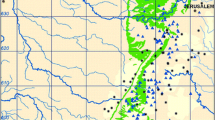Summary
The influences of sampling error in key factor analysis are investigated statistically. The error involved in the data distorts the results in various misleading ways. In the course of detecting key factors by correlation analysis, the distortion arises in the following two ways: (1) the contributions made by the first and the last components of population trend index (logI orK) to the total variation are overrated as compared with the others; and (2) spurious negative correlation arises between successive two components. The risk of misinterpretation due to such disturbance is usually increased further if the error is concentrated on any particular developmental stages. In the tests to detect density-dependence by using regression analysis, the error consistently acts as if it were a density-dependent factor: under the effect of sampling error, the slopeb for the regression of logN i+1 on logN i , for example, is expected to become<1 even where there is no density-dependent factor at all. A set of formulas are derived which may serve to check and correct these misleading distortions caused by the error. It is also shown that such undesirable influences can be avoided, at least to a considerable extent, if appropriate sampling plans are adopted for the study. The validity of key factor analysis is discussed in reference to this and some related problems.
Similar content being viewed by others
References
Clark, L. R., P. W. Geier, R. D. Hughes andR. F. Morris (1967)The ecology of populations in theory and practice. Methuen, London.
Eberhardt, L. L. (1970) Correlation, regression and density dependence.Ecology,51:306–310.
Itô, Y., A. Shibazaki andO. Iwahashi (1969) Biology ofHyphantria cuneaDruly (Lepidoptera: Arctiidae) in Japan. IX. Population dynamics.Res. Popul. Ecol.11:211–228.
Iwao, S. (1968) A new regression method for analyzing the aggregation pattern of animal populations.Res. Popul. Ecol.10:1–20.
Iwao, S. andE. Kuno (1968) Use of the regression of mean crowding on mean density for estimating sample size and the transformation of data for the analysis of variance.Res. Popul. Ecol.10:210–214.
Iwao, S. andE. Kuno (1971) An approach to the analysis of aggregation pattern in biological populations. pp. 461–513 inStatistical ecology Vol. 1 (ed.G. P. Patilet al.). Pennsylvania Univ. Press, University Park and London.
Johnston, J. (1963)Econometric methods. McGraw Hill, New York.
Kendall, M. G. andA. Stuart (1967)The advanced theory of statistics. Vol. 2 (2nd ed.) Griffin, London.
Kuno, E. (1969) A new method of sequential sampling to obtain the population estimates with a fixed level of precision.Res. Popul. Ecol.11:127–136.
Kuno, E. andN. Hokyo (1970) Comparative analysis of the population dynamics of rice leafhoppers,Nephotettix cincticepsUhler andNilaparvata lugensStâl, with special reference to natural regulation of their numbers.Res. Popul. Ecol.12:154–184.
Madansky, A. (1959) The fitting of straight lines when both variables are subject to error.J. Amer. Stat. Assoc.54:137–205.
Maelzer, D. A. (1970) The regression of logNn+1 on logN n as a test of density dependence: An exercise with computer-constructed density independent populations.Ecology51:810–822.
Morris, R. F. (1959) Single factor analysis in population dynamics.Ecology40:580–588.
Morris, R. F. (1963a) pp. 30–37 inThe dynamics of epidemic spruce budworm populations. (ed.R. F. Morris)Mem. Ent. Soc. Canada31.
Morris, R. F. (1963b) Predictive population equations based on key factors.Mem. Ent. Soc. Canada.32:16–21.
Mott, D. G. (1966) The analysis of determination in population systems. pp. 179–194 inSystems analysis in ecology (ed.K. E. F. Watt), Academic Press, London and New York.
Solomon, M. E. (1964) Analysis of processes involved in the natural control of insects.Adv. Ecol. Res.2:1–58.
Southwood, T. R. E. (1966)Ecological methods with particular reference to insect populations. Methuen, London.
St. Amant, J. L. (1970) The detection of regulation in animal populations.Ecology51:823–828.
Tintner, G. (1952)Econometrics. John Wiley and Sons Inc., New York.
Varley, G. C. andG. R. Gradwell (1960) Key factors in population studies.J. Anim. Ecol.29: 399–401.
Varley, G. C. andG. R. Gradwell (1963) The interpretation of insect population changes.Proc. Ceylon Assoc. Adv. Sci.18 (D):142–156.
Varley, G. C. andG. R. Gradwell (1968) Population models for the winter moth. pp. 132–142 inInsect abundance (ed.T. R. E. Southwood). Blackwell, Oxford and Edinburgh.
Varley, G. C. andG. R. Gradwell (1970) Recent advances in insect population dynamics.Ann. Rev. Ent.15:1–24.
Watt, K. E. F. (1963) Mathematical population models for five agricultural crop pests.Mem. Ent. Soc. Canada.32:83–91.
Watt, K. E. F. (1964) Density dependence in population fluctuations.Can. Ent.96:1147–1148.
Watt, K. E. F. (1968)Ecology and resource management. McGraw-Hill, New York.
Author information
Authors and Affiliations
Additional information
Contributions from JIBP-PT No. 120.
Rights and permissions
About this article
Cite this article
Kuno, E. Sampling error as a misleading artifact in “key factor analysis”. Res Popul Ecol 13, 28–45 (1971). https://doi.org/10.1007/BF02522011
Issue Date:
DOI: https://doi.org/10.1007/BF02522011




